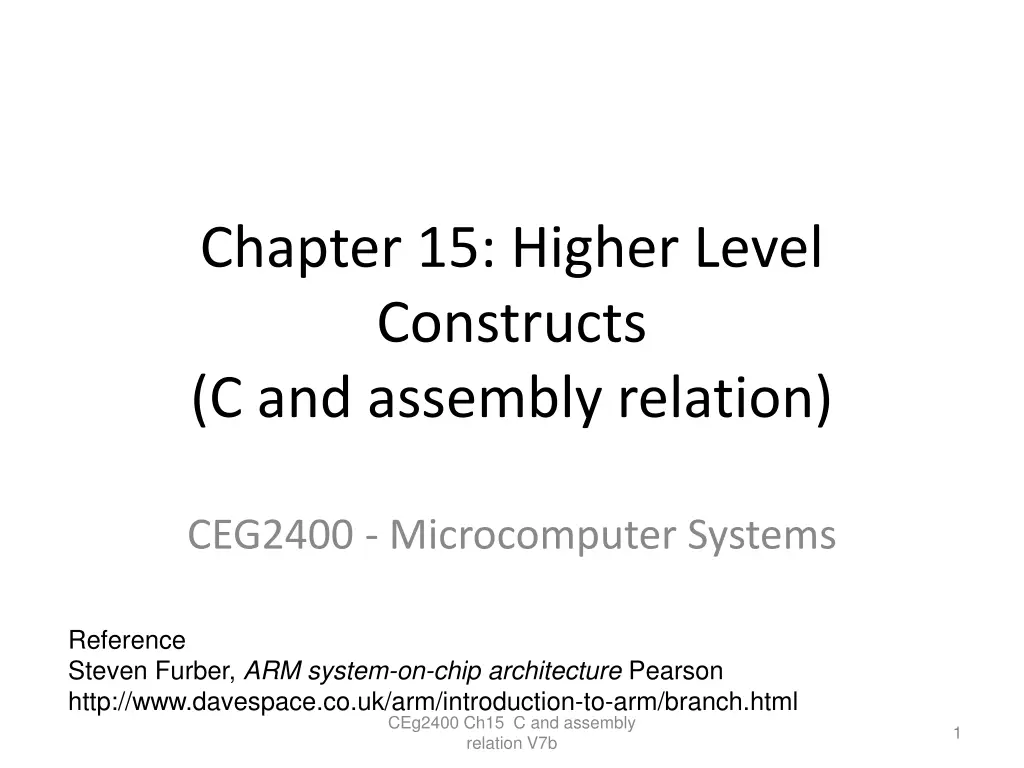
ARM Instruction Set Quick Reference and Usage Examples
Explore the ARM instruction set with quick reference for arithmetic, logical, branching, and load/store operations. Learn how to implement C statements using assembly language. Includes details on operands, shifts, and required fields for executing instructions efficiently.
Download Presentation

Please find below an Image/Link to download the presentation.
The content on the website is provided AS IS for your information and personal use only. It may not be sold, licensed, or shared on other websites without obtaining consent from the author. If you encounter any issues during the download, it is possible that the publisher has removed the file from their server.
You are allowed to download the files provided on this website for personal or commercial use, subject to the condition that they are used lawfully. All files are the property of their respective owners.
The content on the website is provided AS IS for your information and personal use only. It may not be sold, licensed, or shared on other websites without obtaining consent from the author.
E N D
Presentation Transcript
Chapter 15: Higher Level Constructs (C and assembly relation) CEG2400 - Microcomputer Systems Reference Steven Furber, ARM system-on-chip architecture Pearson http://www.davespace.co.uk/arm/introduction-to-arm/branch.html CEg2400 Ch15 C and assembly relation V7b 1
Introduction Part 1: ARM instructions Part 2 : using assembly to implement C statements. Reference http://www.heyrick.co.uk/assembler/qfinder.html CEg2400 Ch15 C and assembly relation V7b 2
Part 1 Instructions CEg2400 Ch15 C and assembly relation V7b 3
Instructions CEG2400 ARM Instruction quick reference.doc http://www.cse.cuhk.edu.hk/~khwong/www2/ceng2400/ARM_Instruction_quick_reference.doc Instructions Arithmetic ADD{condition}{S} Rd, Rn, <Operand> ADC{condition}{S} Rd, Rn, <Operand> SUB{condition}{S} Rd, Rn, <Operand> SBC{condition}{S} Rd, Rn, <Operand> RSB{condition}{S} Rd, Rn, <Operand> RSC{condition}{S} Rd, Rn, <Operand> MUL{condition}{S} Rd, Rm, Rs MLA{condition}{S} Rd, Rm, Rs, Rn UMULL{condition}{S} RdLo, RdHi, Rm, Rs UMLAL{condition}{S} RdLo, RdHi, Rm, Rs SMULL{condition}{S} RdLo, RdHi, Rm, Rs SMLAL{condition}{S} RdLo, RdHi, Rm, Rs Move MOV{condition}{S} Rd, <Operand> MVN{condition}{S} Rd, <Operand> Logical TST{condition} Rn, <Operand> TEQ{condition} Rn, <Operand> AND{condition}{S} Rd, Rn, <Operand> EOR{condition}{S} Rd, Rn, <Operand> ORR{condition}{S} Rd, Rn, <Operand> BIC{condition}{S} Rd, Rn, <Operand> Compare CMP{condition} Rn, <Operand> CMN{condition} Rn, <Operand> Branch B{condition} label BL{condition} label Load / Store STR{condition} Rd, <Addressing_mode1> Stack LDM{condition}<Addressing_mode2> Rn{!}, <register_list> STM{condition}<Addressing_mode2> Rn{!}, <register_list> LDR{condition} Rd, <Addressing_mode1> CEg2400 Ch15 C and assembly relation V7b 4
Required fields Required fields <Operand> Immediate value Register Logical shift left Logical shift right Arithmetic shift right Rotate right E.g. ADD R0, R2, R3,LSL#1 ; R0 = R2 + (R3 << 1) #<immediate_value> Rm Rm, LSL #<shift> Rm, LSR #<shift> Rm, ASR #<shift> Rm, ROR #<shift> CEg2400 Ch15 C and assembly relation V7b 5
Addressing_modes <Addressing_mode1> Zero offset Immediate offset Register offset Post-indexed Post-indexed Pre-indexed Pre-indexed [Rn] [Rn, #+/-< immediate_value>] [Rn, +/-Rm] Immediate offset [Rn], #+/-< immediate_value> Register offset [Rn], +/-Rm Immediate offset [Rn, #+/-< immediate_value>]! Register offset [Rn, +/-Rm]! <Addressing_mode2> Full Descending FD Empty Descending Full Ascending FA Empty Ascending ED EA CEg2400 Ch15 C and assembly relation V7b 6
Optional fields CEG2400 ARM Instruction quick reference.doc Optional fields {condition} EQ Equal NE Not equal MI Negative PL Positive or zero VS Overflow VC No overflow HI Unsigned higher LS Unsigned lower or same GE Signed greater than or equal LT Signed less than GT Signed greater than LE Signed less than or equal CEg2400 Ch15 C and assembly relation V7b 7
Part 2 Using assembly to implement C statements CEg2400 Ch15 C and assembly relation V7b 8
Why? All higher languages (C, C++, Java) must be translated into assembly language/machine code for execution Assemble by an assembler Compilation By a compiler Machine Code in memory Higher level Language C, C++, java Object code In assembly CEg2400 Ch15 C and assembly relation V7b 9
C statements 1) Pointers 2) Arrays 3) Conditional statements : If-then-else; Switch 4) For loop 5) Do while loop 6) While loop CEg2400 Ch15 C and assembly relation V7b 10
1) Pointers in C Each memory address is 8-bit So each 32-bit has 4 locations int *p; //integer is 32-bit p = p + 1; Since p points to a 4-byte value, p must be incremented by 4 Increment the pointer once , increment address 4 times If p is in register r0 add r0,r0,#4 p = p + t; ;P in r0, t in r1 p must be incremented by 4 * t, so if t is in r1 add r0,r0,r1,lsl #2; t=r1, old p=r0. New_p=old_p+t*4 Note: r1 lsl #2 = r1 times 4= t times 4 8-bit CEg2400 Ch15 C and assembly relation V7b 11
Recall : ADD http://www.heyrick.co.uk/assembler/mov.html#add ADD : Addition ADD<suffix> <dest>, <op 1>, <op 2> dest = op_1 + op_2 ADD will add the two operands, placing the result in the destination register. Operand 1 is a register, operand 2 can be a register, shifted register, or an immediate value: ADD R0, R1, R2 ADD R0, R1, #256 ADD R0, R2, R3,LSL#1 ; R0 = R1 + R2 ; R0 = R1 + 256 ; R0 = R2 + (R3 << 1) The addition may be performed on signed or unsigned numbers. CEg2400 Ch15 C and assembly relation V7b 12
2) Arrays Same as pointers since a[i] is the same as *(a + i) CEg2400 Ch15 C and assembly relation V7b 13
;//3) Conditionals in C ; User Initial Stack & Heap AREA |.text|, CODE, READONLY EXPORT __main __main ; ;// if (a > b) ;// c = a; ;//else c = b; ;//The assembly code is as follows; //a, b and c are in r0, r1, r2 resp. mov r0,#1 ; =a,try #1 or #3 to see result mov r1,#2 ; =b cmp r0,r1 ; testing a-b or r0-r1 ; test a<=b ble L1 ; branch to L1"if b is less or equal than a " mov r2,r0 ; c=a, since (a<=b fails), hence a>b b exit ; done L1 mov r2,r1 ; c=b, because a<=b exit end yes a>b? (r0>r1)? no c=a (r2=r0) c=b (r2=r1) CEg2400 Ch15 C and assembly relation V7b 14
Exercise1 Conditionals in C if (a <= b) c = a; else c = b; a, b and c are in r0, r1, r2 resp. Write the assembly code CEg2400 Ch15 C and assembly relation V7b 15
Recall: CMP http://www.heyrick.co.uk/assembler/cmp.html#cmp CMP : Compare CMP<suffix> <op 1>, <op 2> status = op_1 - op_2 CMP allows you to compare the contents of a register with another register or an immediate value, updating the status flags to allow conditional execution to take place. It performs a subtraction, but does not store the result anywhere. Instead, the flags are updated as appropriate. CEg2400 Ch15 C and assembly relation V7b 16
Recall: MOV http://www.heyrick.co.uk/assembler/cmp.html#cmp MOV : Move MOV<suffix> <dest>, <op 1> dest = op_1 MOV loads a value into the destination register, from another register, a shifted register, or an immediate value. You can specify the same register for the effect of a NOP instruction, or you can shift the same register if you choose: MOV R0, R0 ; R0 = R0... NOP instruction MOV R0, R0, LSL#3 ; R0 = R0 * 8 If R15 is the destination, the program counter or flags can be modified. This is used to return to calling code, by moving the contents of the link register into R15: MOV PC, R14 ; Exit to caller MOVS PC, R14 ; Exit to caller preserving flags (not 32-bit compliant) CEg2400 Ch15 C and assembly relation V7b 17
Conditionals The method in the previous slide is the most general case, can have many statements in the if and else parts of the condition For simple cases such as the example, it may be more efficient to use conditional execution, e.g. conditional execution gt For example the following 3 statements can implement if-then-else: CMP r0, #0 ; if (x <= 0) MOVLE r0, #0 ; x = 0; combine MOV+LE in ; one statament is possible in AMR MOVGT r0, #1 ; else x = 1; See http://www.davespace.co.uk/arm/introduction- to-arm/conditional.html CEg2400 Ch15 C and assembly relation V7b 18
Switches in C (application of if-then-else) Can be handled using if statements; use previous methods tmp = e; if (tmp == 0) { point0; } else if (tmp == 1) { point1; } else { pointx; } switch (e) { case 0: point0; case 1: point1; default: pointx; } CEg2400 Ch15 C and assembly relation V7b 19
4) For loop in C for (i = 0; i < 10; i++) { a[i]=3; }//This code could be optimized //in a number of ways, please think about it CEg2400 Ch15 C and assembly relation V7b AREA |.data|, DATA, READWRITE top_of_array DCD 0, 0, 0, 0, 0, 0, 0, 0, 0, 0 ,0 align ; User Initial Stack & Heap AREA |.text|, CODE, READONLY EXPORT __main __main ; mov r1,#3 ldr r2,=top_of_array; r2=pointer to a[0] mov r0,#0 Loop1 cmp r0,#10 bge exit str r1,[r2] add r2,#4 add r0,#1 b Loop1 exit end; Top_of_array r2=a[0] ;value 3 to save in a[i] a[i] ;i is r0, initial i=0 ; if i >= 10 done ; branch exit if greater ; store r1(=3) in a[i] pointed by r ; a[0]+i*4 point to next location ;i++ NEXT [ ] is Indirect addressing, store the value in r1 into the address pointed by r2 20
Exercise 2 for (i = 0; i < 10; i++){ a[i]=i-1; } Write the assembly code. CEg2400 Ch15 C and assembly relation V7b 21
4: for (i=1;i<10;i++) 5: { 0x000002AC E3A01001 MOV R1,#0x00000001 0x000002B0 EA000005 B 0x000002CC 6: if (i <= 5) 0x000002B4 E3510005 CMP R1,#0x00000005 0x000002B8 CA000001 BGT 0x000002C4 7: c = 0; 8: else 0x000002BC E3A02000 MOV R2,#0x00000000 0x000002C0 EA000000 B 0x000002C8 9: c = 1; 10: } 0x000002C4 E3A02001 MOV R2,#0x00000001 4: for (i=1;i<10;i++) 5: { 6: if (i <= 5) 7: c = 0; 8: else 9: c = 1; 10: } 0x000002C8 E2811001 ADD R1,R1,#0x00000001 0x000002CC E351000A CMP R1,#0x0000000A 0x000002D0 BAFFFFF7 BLT 0x000002B4 11: } C-disassembly : for loop for (i=1;i<10;i++) { if (i <= 5) c = 0; else c = 1; } ;when run debug you will get the disassembler window 22 CEg2400 Ch15 C and assembly relation V7b
Recall: LDR or STR http://www.heyrick.co.uk/assembler/str.html#ldr Single Data Transfer The single data transfer instructions (STR and LDR) are used to load and store single bytes or words of data from/to main memory. The addressing is very flexible. First, we'll look at the instruction: LDR R0, address;(load 4 bytes) STR R0, address;(load 4 bytes) LDRB R0, address ;(load single byte) STRB R0, address; (store single byte) For LDRLS : LS =the optional field, will execute LDR if the condition LS is satisfied . LS =Unsigned lower or same 23 CEg2400 Ch15 C and assembly relation V7b
5) Do_while one branch is enough Do_while {..do_something.. body; } while (conditional expression); LOOP { do_something.. ; body bne LOOP ;conditional expression EXIT }; CEg2400 Ch15 C and assembly relation V7b 24
6) While_do loop requires 2 branch instructions While_do (conditional_expr) {do_something body;} LOOP EXIT beq exit ;branch exit if condition met do_something ; main body b LOOP ; not conditional_expr The main loop has 2 branch instructions: slower CEg2400 Ch15 C and assembly relation V7b 25
Alterative method while_do(), the following is more efficient, because The main loop has only 1 branch instruction only (FAST). Note: Branch is time-consuming to run in hardware, so avoid using too many of them. C language: While_do (conditional expr){ do_something...} Assembly:; do some test first before get into LOOP b TEST ; goto TEST inside the loop first ; hence one branch is need inside the loop LOOP do_something ..; loop main body TEST ; exit test conditional expression bne LOOP ;loop back if exit condition not met EXIT Goto exit if test exit condition is met 26 CEg2400 Ch15 C and assembly relation V7b
Exercise 3: Write an assembly program segment for the following C-language module. Assume a is in register r0, b is in register r1 and c is in register r2. The variables a, b, and c are unsigned integers. if (a < b) c = a; else c = b; CEg2400 Ch15 C and assembly relation V7b 27
; Exercise 4 ;Assume a, b and c are in registers r0, r1 and r2 respectively. ;Write the C-language segment of the following ARM assembly program. __main ;a, b and c are in r0, r1, r2 resp. mov r0,#2 mov r1,#1 mov r2,#0 cmp r0,r1 ble l1 mov r2,r0 add r2,#2 b end l1 mov r2,r0 exit nop; end CEg2400 Ch15 C and assembly relation V7b 28
Summary Studied the relation between assembly and higher level languages CEg2400 Ch15 C and assembly relation V7b 29
Appendix1 Recall: AND AND : Logical AND AND<suffix> <dest>, <op 1>, <op 2> dest = op_1 AND op_2 AND will perform a logical AND between the two operands, placing the result in the destination register; this is useful for masking the bits you wish to work on. Operand 1 is a register, operand 2 can be a register, shifted register, or an immediate value: AND R0, R0, #3 ; R0 = Keep bits zero and one of R0, discard the rest. An AND table (result = both): Op_1 Op_2 Result 0 0 0 0 1 0 1 0 0 1 1 1 CEg2400 Ch15 C and assembly relation V7b 30
//self studying exercises, no need to submit to the teacher. //http://www.cse.cuhk.edu.hk/~khwong/www2/ceng2400/ testing_C_and_assembly.c //Appendix: testing C and assembly conversion // run this program and read contents in the disassembly window in uvision //Exercises: Use single step to run it, and answer the questions below. #include <lpc21xx.h> int a[4],b[4],c,i; main() { for(;;) //testing forever { //test 1, looping for (i=1;i<10;i++) { if (i <= 5) c = 0; else c = 1; } //Question1a: Where does the program store i and c? //Question1b: Draw the flow diagram of the program. //test 2, looping and array for (i = 0; i < 4; i++) {a[i]=0; b[i]=0;//clear the arrays } for (i = 0; i < 10; i++) {a[i]=3+i; //set values into the array }//question2a: Find a bug in the above program. //question2b: What is the actual result of running the code? //test 3, looping i=0,c=0; //clear i,c while (i<5) {c++; i++; } //Question3a: Where does the program store i and c? //Question3b: Draw the flow diagram of the program. //test 4, test switching i=0,c=1; //clear variables for(i=0;i<5;i++) { switch (i) { case 0: c=0; case 1: c=1; case 2: c=2; case 3: c=3; case 4: c=4; default: c=0; } } } //question4a: Explain how switch-case is implemented here. //question4b: Suggest an alternative method for the implementation. CEg2400 Ch15 C and assembly relation V7b 31 }
Recall: ADR (Pseudo instructions) ADR : load ADRess The disassembler shows that ADR becomes two 32-bit instructions, So ADR is called a pseudo instruction ADR<suffix> <register>, <label> This loads the address referred into the given register: 00008FE4 OPT l% 00008FE4 E28F0004 ADR R0, text 00008FE8 EF000002 SWI "OS_Write0" 00008FEC E1A0F00E MOV PC, R14 00008FF0 .text 00008FF0 EQUS "Hello!" + CHR$13 + CHR$10 + CHR$0 00008FFC ALIGN CEg2400 Ch15 C and assembly relation V7b 32





